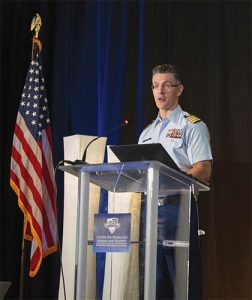Everyone is a Leader: Imagining The Potential of Today’s Youth by Captain Samson C. Stevens, Sr.
Leadership. We often think of leadership in terms of military soldiers and sailors courageously defending our Nation, or senior Generals and Admirals directing strategic forces as part of international campaign planning, or Chief Executive Officers of major corporations innovating new business lines and managing global supply chains, or First Responders arriving at the scene of tragedy or disaster and helping communities and people to recover and rebuild. Yes, this is indeed leadership, but not exclusively!
When we look for authoritative definitions, entries abound — books and articles, how-to guides, coaching and consultants, it’s all there. Kevin Kruse surveys several successful leaders’ definitions, before settling on: “A process of social influence, which maximizes the efforts of others, towards the achievement of a goal.”[1] Simon Sinek in his Ted2014 talk notes that “Leadership is a choice, not a rank. Anyone in an organization can be a leader. It’s choosing to look out for the person on your left and to look out for the person on your right.”[2]
Both of the above resonate with me, but I also believe we sometimes overthink leadership and how we identify those who wear the mantle of being a leader. In fact, rather than being relegated to the upper crust of organizations and seniority, what we need more of in our Nation are leaders at every level — young and old, apprentices and masters, junior and senior alike. We need to teach leadership at an early age, so that we can help the leaders of tomorrow recognize the impact one can have when a vision of service and leadership helps to unify rather than divide, and bolsters our communities, our schools, our government, our institutions…and our Nation to be stronger and more resilient to the host of existential threats facing our country today.
I’ve been part of the United States Coast Guard for 33 years, and my Command Philosophy of “Serve First, Lead Second, Be Humble”[3] emphasizes leadership at every level (figure 1). While working as the Captain of the Port of Virginia, I frequently told the story of a former Captain of the Port, CAPT John Little, and how he emphasized the value of our junior members as leaders. As the story goes, CAPT Little was receiving an update from a senior watchstander about an ongoing search and rescue case, to include all the critical details such as the location of the vessel in distress, the assets dispatched to help, the condition of the passengers on board, on-scene weather and so on. At the conclusion of the brief, he turned to the most junior member of the duty team, a third-class petty officer (an E-4 in the Coast Guard) and asked him if he had any additional information to provide. The young petty officer was surprised by the Captain asking him if he had anything to contribute, and said that as a brand new member of the Command Center team, and as only a third class, that he didn’t think he had anything to offer. CAPT Little remarked that on the contrary, a third-class petty officer in the United States Coast Guard, having completed all qualifications and training, and as an integrated member of the team, was exactly in a position to provide relevant information and insights regarding the ongoing case, and most importantly, information of value to the Captain. When we empower our junior members to provide contributions to our processes, our organizations, and to help us ensure we are thinking about all possible ideas, we build cultures that promote innovation, trust, and unity of effort. Imagine a world where we shape the young minds who will lead tomorrow’s country forward with such a mindset.
Recently I had the opportunity to attend a Career Fair at Crestwood Elementary School, in Great Bridge, VA. My wife, a (highly regarded and accomplished!) School Psychologist for the school had asked me to talk about my time in the Coast Guard, and I soon found myself face-to-face with six back-to-back classes of 25 5th-graders.
Bright-eyed and excited, I could not have been more nervous — and charged! — to talk to them about the job I have loved doing for three decades. I also realized that this group of 150 children were learning today about the value of Service and Leadership in their school. As I pledged allegiance to the flag with them during their morning routine, I was overwhelmed seeing the opportunity we have in front of us every day to instill the values of Leadership and Service in young people who are the leaders of tomorrow.
My own journey as a parent of three teenagers has taught me through the school of hard-knocks just how much learning and adapting my wife and I have experienced to instill this spirit within our children. It has required dramatic growth in parenting to evolve from a directive style of parenting, to an advising and coaching approach, all while building the trust and expectations necessary to help them consider their own role as leaders in their school and community. I’ve seen them excel in seeking sports team and student association leadership roles, while growing to recognize that their voices and contributions absolutely can have positive impacts on those around them, the faculty and coaches, the students, and the culture of the school.
What if we encouraged more of today’s youth with an “Everyone is a Leader” approach to enable them with the same sense of contribution, value, and impact that the third class petty officer had when the Captain asked him about his thoughts on a search and rescue case? What if students realized that ascribing to values of Service, Leadership, and Humility could be a pivotal starting place to recapture some of the pride and hard work that is representative of our Nation’s character? What if these students learned that they are much stronger working together than working apart on the hard issues facing our world today? Imagine the leadership opportunities for young people to be part of making communities stronger: spearheading as part of litter clean-up crews, with volunteering to provide work and help work for to those in need, conducting community service and contributions to small business and civic associations, and promoting a culture of respect and humanity among their peers. All this while and inculcating self-awareness and a culture of values that includes responsibility for the future of our country, its land, environment, and population. I cannot think of a better place to start with than our students. I believe they are ready for the call — are we ready to trust them? . ❦
References
[1] Kevin Kruse, “What is Leadership”, Forbes.com, April 9, 2013. https://www.forbes.com/sites/kevinkruse/2013/04/09/what-is-leadership/?sh=594a90335b90
[2] Simon Sinek, Ted Blog, March 21, 2014. https://blog.ted.com/leadership-is-about-making-others-feel-safe-simon-sinek-at-ted2014/
[3] Samson Stevens, “Serve First, Lead Second, Be Humble”, U.S. Naval Institute, Proceedings, August 2022. https://www.usni.org/magazines/proceedings/2022/august/serve-first-lead-second-be-humble
 About the Author
About the Author
As the Chief of Atlantic Area Intelligence, he leads the efforts of 330 intelligence professionals across 5 COCOMs and throughout five Coast Guard Districts, 26 Sectors, 13 air stations, and the Maritime Intelligence Fusion Center Atlantic. As the Senior Intelligence Officer he oversees the service’s intelligence programs to drive theater and tactical intelligence operations enabling Service and Department missions. He is responsible for integrating Service policy and oversight of collection activities, analysis and production, geospatial intelligence, counterintelligence, cryptology and critical information technology and security functions throughout the Atlantic Area.
Prior to Atlantic Area Intelligence, Captain Stevens served as Commander, Sector Virginia, where he led 1,100 Coast Guard women and men, among 13 field commands to conduct Coast Guard missions in the Commonwealth of Virginia’s waters and offshore.
Captain Stevens has over 29 years of experience in a broad array of operational, intelligence, joint, and staff assignments to include: Coast Guard Cutter MALLOW; the National Drug Intelligence Center; Coast Guard Headquarters Office of Design and Engineering Standards and Office of Standards Evaluation and Development; Chief, Contingency Preparedness and Force Readiness, Sector Delaware Bay; Liaison Officer to U.S. Fleet Forces Command and Joint Staff; and Executive Officer, Maritime Intelligence Fusion Center Pacific. Prior to his service at Sector Virginia, he served as the Special Assistant to the 25th Commandant of the Coast Guard, ADM Paul Zukunft, where he was responsible for the daily and long-term administration of the Commandant’s strategic priorities.
A 1995 graduate of the U.S. Coast Guard Academy in New London, Connecticut, he earned a Bachelor of Science degree in Mechanical Engineering. He later earned a Master of Science degree in Naval Architecture and Marine Engineering and a Master of Arts degree in Kinesiology from the University of Michigan, in Ann Arbor, MI (2001). He also earned a Master of Arts degree in National Security and Strategic Studies from the U.S. Naval War College in Newport, RI, (2011) and an Intelligence Community Graduate Certificate from the National Intelligence University in Washington, D.C. (2016). In 2023, he graduated from the Naval Postgraduate School Center for Homeland Defense and Security Executive Leaders Program.
Captain Stevens’ decorations include Coast Guard Meritorious Service, Coast Guard Commendation, and Coast Guard Achievement Medals, the National Intelligence Meritorious Unit Commendation, and several Unit and Service awards.
